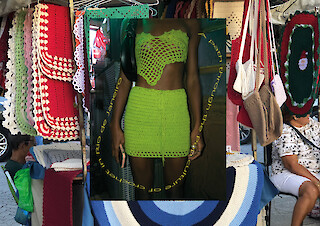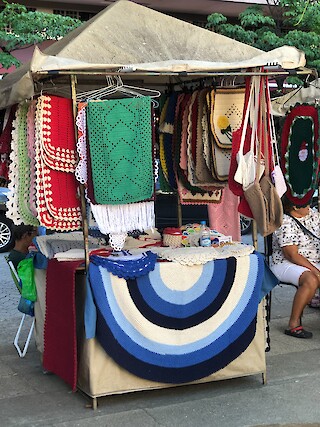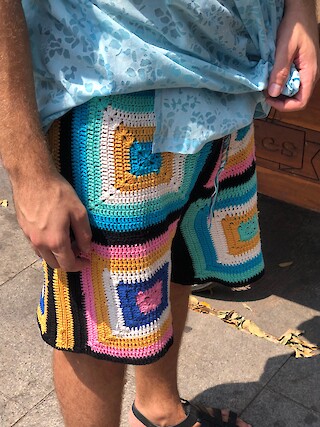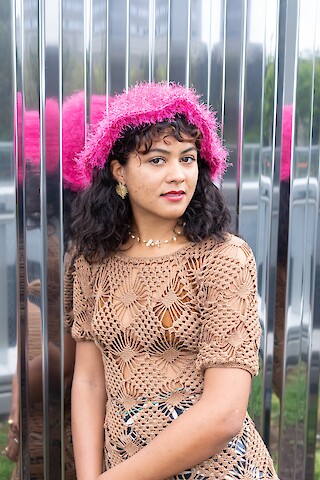
A Path through the Pop Culture of Crochet in Rio de Janeiro
michelle.wanzenried@hotmail.com
@siliciumdioxid
[DE]
Wir feiern das Besondere und Neue. Zeitgenössisches kulturelles Erbe wird dabei nicht wahrgenommen. Die ethnografische Forschung zeichnet jedoch ein anderes Bild: Die Untersuchung der zeitgenössischen Transformationen der Häkelkultur in Rio de Janeiro zeigt, dass Häkeln als lebendiges kulturelles Erbe fortgeführt wird. Als omnipräsente Praxis und eigenwilliger Stil jenseits normierter Schönheitsstandards prägt es das urbane Bild der Stadt.
Das generierte visuelle Material wird als Archiv in einer Open-Resource-Box zur Verfügung gestellt. Analog und haptisch bildet es einen Gegenpol zur generischen digitalen Bilderflut, deren Homogenität uns allmählich zu langweilen beginnt. Die Archivbox – gefüllt mit schnappschussartigen, unbearbeiteten, vor Ort aufgenommen Bildern im A6-Format – ist modular, modifizier- und erweiterbar. Als ungeschönter Rohstoff soll sie zukünftig all jenen dienen, die Inspirationsquellen und Forschungsmaterial abseits digitaler Datenbanken suchen.
[EN]
As a culture, we celebrate the extraordinary and the brand-new. Things seen daily are taken for granted. Contemporary cultural heritageis not recognized. This ethnographic research explores the contemporary transformations of crochet culture, the unconventional styles beyond narrow beauty standards and their presence in the city landscape. The new aesthetics in Rio de Janeiro reveal that the cultural heritage of crochet is still a living practice.
Overall, this research aims to shed light on the unseen stories and cultural significance of crochet in Rio de Janeiro’s popular culture. The generated visual material is made available as an archive in an open resource box. Analogue and tactile, it creates a counterpoint to the generic digital imagery overload. The archive box – filled with snapshot-like, unedited images in A6 format taken on location with a smartphone – is modular, modifiable and expandable. In the future, it can serve as unadorned raw material and a resource for research and inspiration.
Knowledge cannot be fully acquired.
This is a work in progress. A presentation of images and gathered knowledge progressing over time. There is often a belief that knowledge must be complete in order to share with a wider public. Instead, here, I present an opportunity for both the knowing and not-knowing. I present a work in progress as an opening for vulnerability, collaboration, discussion, and growth.

Design has always had a relationship with people outside of the design industry. However, good cultural education is often seen as a privilege for those who can afford it and have the time to consume design. Pop culture is often hidden in daily life, with people using or possessing cultural objects without knowing they are in touch with them and this is making the cultural capital of their lives. For example, the crochet look is a part of Brazilian culture and is easy to talk about, with knowledge about it being inclusive, regardless of social status. It’s important to recognize it as a form of design, even without an higher intellectual art/design education.
In urban settings, where anonymity is more prevalent, it is often easier to choose a hobby that has often been associated with femininity. What’s particularly exciting is that crochet, traditionally viewed as a feminine hobby, is evolving into a form of artistic expression for a diverse group of individuals. This focus delves into the changing aesthetics of crochet across different communities and gender. We see how crochet is breaking barriers and becoming a form of artistic and social expression. This once traditional craft is transcending gender norms and evolving into something that brings people together from all walks of life.

Granny Square worn by a young men. Crochet represents much more than just craftsmanship. Everyone has the free way to interpret the style they want to embrace. It’s inclusive design for everyone and showcases how design and fashion can be used to express and preserve cultural identity.
